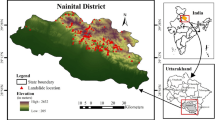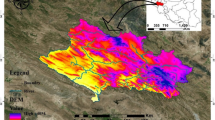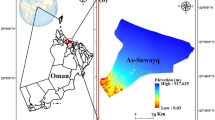Abstract
Sagar Island, located in the Indian Sundarbans Delta, is extremely vulnerable to storm surge flooding. Therefore, there is a need for a precise model to assess its susceptibility to storm surges, which is essential for efficient coastal management and reducing the risk of disasters. Traditional modeling methods often lack the capability to consider the intricate relationships between various influencing factors. This study aims to advance the field by developing robust deep learning (DL) models for storm surge susceptibility prediction, specifically incorporation of Bayesian optimization with DL models and implementing Explainable Artificial Intelligence (XAI) methods for model interpretation and data-driven management. Storm surge susceptibility in Sagar Island presents a critical problem requiring advanced predictive modeling. We employ Bayesian Optimization for hyperparameter tuning in Deep Neural Networks (DNN), 1D Convolutional Neural Networks (CNN), and LightGBM models, focusing on 11 variables with low multi-collinearity. Additionally, we applied Explainable AI techniques such as SHapley Additive exPlanations (SHAP) and permutation importance for model interpretability. DNN achieved the highest accuracy of 97.75%, with F1-score at 97.85%. LightGBM and CNN were close competitors with an accuracy of 97.5%. DNN’s true positive rate was 95%, compared to CNN’s 94% and LightGBM’s 93%. In the susceptibility mapping analysis, the CNN detected areas categorized as ‘Very Low’ and ‘Very High’ susceptibility, constituting 65.12% of the study area and covering 156.88 km² and 11.38% covering 11.38 km², respectively. Similarly, LightGBM exhibited a comparable pattern, but with a more pronounced representation of ‘High’ susceptibility zones, spanning 22.61 km², predominantly across the coastal and central regions of Sagar Island. Feature importance assessed through SHAP revealed “Rainfall” as 40% more impactful than “Cyclone Track.” While all three models demonstrated robust performance, DNN emerged as marginally superior in most evaluated metrics. Our study provides valuable insights for targeted storm surge management strategies in Sagar Island, combining high predictive accuracy with model interpretability.













Similar content being viewed by others
Data availability
“The datasets used and/or analyzed during the current study are available from the corresponding author on reasonable request”.
References
Al-Juaidi AE, Nassar AM, Al-Juaidi OE (2018) Evaluation of flood susceptibility mapping using logistic regression and GIS conditioning factors. Arab J Geosci 11:1–10
Al-Najjar HA, Pradhan B, Beydoun G, Sarkar R, Park HJ, Alamri A (2022) A novel method using explainable artificial intelligence (XAI)-based Shapley additive explanations for spatial landslide prediction using time-series SAR dataset. Gondwana Res 123:107–124
Ali SA, Khatun R, Ahmad A, Ahmad SN (2019) Application of GIS-based analytic hierarchy process and frequency ratio model to flood vulnerable mapping and risk area estimation at Sundarban region, India. Model Earth Syst Environ 5:1083–1102. https://doi.org/10.1007/s40808-019-00593-z
An NN, Nhut HS, Phuong TA et al (2022) Groundwater simulation in Dak Lak province based on MODFLOW model and climate change scenarios. Front Eng Built Environ 2:55–67. https://doi.org/10.1108/FEBE-11-2021-0055
Arora A, Pandey M, Siddiqui MA et al (2021) Spatial flood susceptibility prediction in middle Ganga plain: comparison of frequency ratio and Shannon’s entropy models. Geocarto Int 36:2085–2116
Aydin HE, Iban MC (2023) Predicting and analyzing flood susceptibility using boosting-based ensemble machine learning algorithms with Shapley additive explanations. Nat Hazards 116(3):2957–2991
Başağaoğlu H, Chakraborty D, Lago CD, Gutierrez L, Şahinli MA, Giacomoni M, engör SS (2022) A review on interpretable and explainable artificial intelligence in hydroclimatic applications. Water 14(8):1230
Bera R, Maiti R (2021) Multi hazards risk assessment of Indian Sundarbans using GIS based analytic hierarchy process (AHP). Reg Stud Mar Sci 44:101766
Bera R, Maiti R (2021a) Multi hazards risk assessment of Indian Sundarbans using GIS based analytic hierarchy process (AHP). Reg Stud Mar Sci 44:101766
Bera S, Guru B, Chatterjee R, Shaw R (2020) Geographic variation of resilience to landslide hazard: a household-based comparative studies in Kalimpong hilly region, India. Int J Disaster Risk Reduct 46:101456. https://doi.org/10.1016/j.ijdrr.2019.101456
Bera A, Meraj G, Kanga S et al (2022) Vulnerability and risk assessment to climate change in Sagar Island, India
Bittermann K, Rahmstorf S, Perrette M, Vermeer M (2013) Predictability of twentieth century sea-level rise from past data. Environ Res Lett. https://doi.org/10.1088/1748-9326/8/1/014013
Brakenridge GR, Syvitski JPM, Overeem I et al (2013) Global mapping of storm surges and the assessment of coastal vulnerability. Nat Hazards 66:1295–1312. https://doi.org/10.1007/s11069-012-0317-z
Brooks N (2003) Vulnerability, risk and adaptation: a conceptual framework. Tyndall Centre Clim Chang Res Work Pap 38(38):1–16
Bui QT, Nguyen QH, Nguyen XL, Pham VD, Nguyen HD, Pham VM (2020) Verification of novel integrations of swarm intelligence algorithms into deep learning neural network for flood susceptibility mapping. J Hydrol 581:124379
Chen W, Li Y (2020) GIS-based evaluation of landslide susceptibility using hybrid computational intelligence models. Catena 195:104777. https://doi.org/10.1016/j.catena.2020.104777
Chou TY, Hoang TV, Fang YM, Nguyen QH, Lai TA, Pham VM, Bui QT (2021) Swarm-based optimizer for convolutional neural network: an application for flood susceptibility mapping. Trans GIS 25(2):1009–1026
Costache R, Ngo PTT, Bui DT (2020) Novel ensembles of deep learning neural network and statistical learning for flash-flood susceptibility mapping. Water 12(6):1549
Dubey SK, Trivedi RK, Chand BK et al (2017) Farmers’ perceptions of climate change, impacts on freshwater aquaculture and adaptation strategies in climatic change hotspots: a case of the Indian Sundarban delta. Environ Dev 21:38–51. https://doi.org/10.1016/j.envdev.2016.12.002
Ellis JT, Sherman DJ (2015) Perspectives on coastal and marine hazards and disasters. Coastal and marine hazards, risks, and disasters. Elsevier, pp 1–13
Emami SN, Yousefi S, Pourghasemi HR et al (2020) A comparative study on machine learning modeling for mass movement susceptibility mapping (a case study of Iran). Bull Eng Geol Environ 79:5291–5308. https://doi.org/10.1007/s10064-020-01915-7
Emanuel K (2005) Increasing destructiveness of tropical cyclones over the past 30 years. Nature 436:686–688
Falah F, Rahmati O, Rostami M, Ahmadisharaf E, Daliakopoulos IN, Pourghasemi HR (2019) Artificial neural networks for flood susceptibility mapping in data-scarce urban areas. Spatial modeling in GIS and R for Earth and Environmental sciences. Elsevier, pp 323–336
Ganguly KK, Nahar N, Hossain BM (2019) A machine learning-based prediction and analysis of flood affected households: a case study of floods in Bangladesh. Int J Disaster Risk Reduct 34:283–294. https://doi.org/10.1016/j.ijdrr.2018.12.002
Ghosh S, Mistri B (2021) Assessing coastal vulnerability to environmental hazards of Indian Sundarban delta using multi-criteria decision-making approaches. Ocean Coast Manag 209:105641. https://doi.org/10.1016/j.ocecoaman.2021.105641
Gopinath G, Seralathan P (2005) Rapid erosion of the coast of Sagar island, West Bengal-India. Environ Geol 48:1058–1067
Hadipour V, Vafaie F, Deilami K (2020) Coastal flooding risk assessment using a GIS-based spatial multi-criteria decision analysis approach. Water. https://doi.org/10.3390/W12092379
Hagos YG, Andualem TG, Yibeltal M, Mengie MA (2022) Flood hazard assessment and mapping using gis integrated with multi-criteria decision analysis in upper Awash River basin, Ethiopia. Appl Water Sci 12:1–18. https://doi.org/10.1007/s13201-022-01674-8
Iban MC, Bilgilioglu SS (2023) Snow avalanche susceptibility mapping using novel tree-based machine learning algorithms (XGBoost, NGBoost, and LightGBM) with explainable artificial intelligence (XAI) approach. Stoch Environ Res Risk Assess 37(6):2243–2270
Islam ARMT, Talukdar S, Mahato S et al (2021) Machine learning algorithm-based risk assessment of riparian wetlands in Padma River Basin of Northwest Bangladesh. Environ Sci Pollut Res 28:34450–34471. https://doi.org/10.1007/s11356-021-12806-z
Islam ARMT, Talukdar S, Mahato S, Kundu S, Eibek KU, Pham QB, Linh NTT (2021b) Flood susceptibility modeling using advanced ensemble machine learning models. Geosci Front 12(3):101075
Islam ARMT, Bappi MMR, Alqadhi S, Bindajam AA, Mallick J, Talukdar S (2023) Improvement of flood susceptibility mapping by introducing hybrid ensemble learning algorithms and high-resolution satellite imageries. Nat Hazards 119(1):1–37
Ismail, Mohmand MI, Hussain H et al (2022) A machine learning-based classification and prediction technique for DDoS attacks. IEEE Access 10:21443–21454. https://doi.org/10.1109/ACCESS.2022.3152577
Jennifer JJ (2022) Feature elimination and comparison of machine learning algorithms in landslide susceptibility mapping. Environ Earth Sci 81:1–23. https://doi.org/10.1007/s12665-022-10620-5
Kalantar B, Ueda N, Saeidi V, Janizadeh S, Shabani F, Ahmadi K, Shabani F (2021) Deep neural network utilizing remote sensing datasets for flood hazard susceptibility mapping in Brisbane, Australia. Remote Sens 13(13):2638
Khan MJU, Durand F, Bertin X et al (2021) toward an efficient storm surge and inundation forecasting system over the Bengal delta: chasing the Supercyclone Amphan. Nat Hazards Earth Syst Sci 21:2523–2541. https://doi.org/10.5194/nhess-21-2523-2021
Khan J, Ren X, Hussain MA, Jan MQ (2022) Monitoring land subsidence using PS-InSAR technique in Rawalpindi and Islamabad, Pakistan. Remote Sens 14:3722
Lai TA, Nguyen NT, Bui QT (2023) Hyper-parameter optimization of gradient boosters for flood susceptibility analysis. Trans GIS 27(1):224–238
Li W, Liu Y, Liu Z, Gao Z, Huang H, Huang W (2022) A positive-unlabeled learning algorithm for urban flood susceptibility modeling. Land 11(11):1971
Liu Y, Lu C, Yang X et al (2020) Fine-scale coastal storm surge disaster vulnerability and risk assessment model: a case study of Laizhou Bay, China. Remote Sens 12:1301. https://doi.org/10.3390/rs12081301
Liuzzo L, Sammartano V, Freni G (2019) Comparison between different distributed methods for flood susceptibility mapping. Water Resour Manag 33:3155–3173
Mondal M, Biswas A, Haldar S et al (2022) Climate change, multi-hazards and society: an empirical study on the coastal community of Indian Sundarban. Nat Hazards Res 2:84–96. https://doi.org/10.1016/j.nhres.2022.04.002
Nandi S, Ghosh M, Kundu A et al (2016) Shoreline shifting and its prediction using remote sensing and GIS techniques: a case study of Sagar Island, West Bengal (India). J Coast Conserv 20:61–80. https://doi.org/10.1007/s11852-015-0418-4
Nasrin T, Ramiz M, Sarif MN et al (2020) Natural hazards modeling of impact assessment of super cyclone Amphan with machine learning algorithms in Sundarban Biosphere Reserve, India. Nat Hazards. https://doi.org/10.1007/s11069-023-05935-w
Paszkowski A, Goodbred S Jr, Borgomeo E et al (2021) Geomorphic change in the Ganges–Brahmaputra–Meghna delta. Nat Rev Earth Environ 2:763–780
Pedersen TL, Benesty M (2018) Lime: local interpretable model-agnostic explanations. R package version 0.4, 1
Pielke RA Jr, Gratz J, Landsea CW et al (2008) Normalized hurricane damage in the United States: 1900–2005. Nat Hazards Rev 9:29–42
Rahmati O, Darabi H, Panahi M, Kalantari Z, Naghibi SA, Ferreira CSS, Haghighi AT (2020) Development of novel hybridized models for urban flood susceptibility mapping. Sci Rep 10(1):12937
Saber M, Boulmaiz T, Guermoui M, Abdrabo KI, Kantoush SA, Sumi T, Mabrouk E (2022) Examining LightGBM and CatBoost models for wadi flash flood susceptibility prediction. Geocarto Int 37(25):7462–7487
Sahana M, Sajjad H (2019) Vulnerability to storm surge flood using remote sensing and GIS techniques: a study on Sundarban Biosphere Reserve, India. Remote Sens Appl Soc Environ 13:106–120. https://doi.org/10.1016/j.rsase.2018.10.008
Sahana M, Rehman S, Sajjad H, Hong H (2020) Exploring effectiveness of frequency ratio and support vector machine models in storm surge flood susceptibility assessment: a study of Sundarban Biosphere Reserve India. J Catena. https://doi.org/10.1016/j.catena.2019.104450
Sahana M, Rehman S, Ahmed R, Sajjad H (2021) Assessing losses from multi-hazard coastal events using poisson regression: empirical evidence from Sundarban Biosphere Reserve (SBR) India. J Coast Conserv India. https://doi.org/10.1007/s11852-021-00804-9
Sarkar SK, Talukdar S, Rahman A et al (2021) Groundwater potentiality mapping using ensemble machine learning algorithms for sustainable groundwater management. Front Eng Built Environ 2:43–54. https://doi.org/10.1108/FEBE-09-2021-0044
Seydi ST, Kanani-Sadat Y, Hasanlou M, Sahraei R, Chanussot J, Amani M (2022) Comparison of machine learning algorithms for flood susceptibility mapping. Remote Sens 15(1):192
Shi X, Chen B, Liang Y et al (2021) Inundation simulation of different return periods of storm surge based on a numerical model and observational data. Stoch Environ Res Risk Assess 35:2093–2103
Stančić I, Musić J, Grujić T et al (2022) Comparison and evaluation of machine learning-based classification of hand gestures captured by inertial sensors. Computation. https://doi.org/10.3390/computation10090159
Swain KC, Singha C, Nayak L (2020) Flood susceptibility mapping through the GIS-AHP technique using the cloud. ISPRS Int J Geo-Inform. https://doi.org/10.3390/ijgi9120720
Takagi H, Esteban M, Mikami T, Fujii D (2016) Projection of coastal floods in 2050 Jakarta. Urban Clim 17:135–145
Talukdar S, Ghose B, Shahfahad, Salam R, Mahato S, Pham QB, Avand M (2020) Flood susceptibility modeling in Teesta River basin, Bangladesh using novel ensembles of bagging algorithms. Stoch Env Res Risk Assess 34:2277–2300
Towfiqul Islam ARM, Talukdar S, Mahato S et al (2021) Flood susceptibility modeling using advanced ensemble machine learning models. Geosci Front. https://doi.org/10.1016/j.gsf.2020.09.006
Ullah K, Wang Y, Fang Z et al (2022) Multi-hazard susceptibility mapping based on convolutional neural networks. Geosci Front 13:101425
Vision A (2011) WWF in numbers Indian Sundarbans Delta
Wang J, Gao W, Xu S, Yu L (2012) Evaluation of the combined risk of sea level rise, land subsidence, and storm surges on the coastal areas of Shanghai, China. Clim Change 115:537–558
Wang Y, Fang Z, Hong H, Peng L (2020) Flood susceptibility mapping using convolutional neural network frameworks. J Hydrol 582:124482
Xianwu S, Bingrui C, Jufei Q et al (2021) Simulation of inundation caused by typhoon-induced probable maximum storm surge based on numerical modeling and observational data. Stoch Environ Res Risk Assess 35:2273–2286. https://doi.org/10.1007/s00477-021-02034-9
Xie W, Nie W, Saffari P, Robledo LF, Descote PY, Jian W (2021) Landslide hazard assessment based on bayesian optimization–support vector machine in Nanping City, China. Nat Hazards 109(1):931–948
Yang R, Zheng G, Hu P et al (2022) Snowmelt flood susceptibility assessment in Kunlun mountains based on the Swin transformer deep learning method. Remote Sens 14:6360
Youssef AM, Pourghasemi HR (2021) Landslide susceptibility mapping using machine learning algorithms and comparison of their performance at Abha Basin, Asir Region, Saudi Arabia. Geosci Front 12:639–655. https://doi.org/10.1016/j.gsf.2020.05.010
Youssef AM, Pradhan B, Dikshit A, Mahdi AM (2022) Comparative study of convolutional neural network (CNN) and support vector machine (SVM) for flood susceptibility mapping: a case study at Ras Gharib, Red Sea, Egypt. Geocarto Int 37(26):11088–11115
Youssef AM, Pradhan B, Dikshit A, Mahdi AM (2022a) Comparative study of convolutional neural network (CNN) and support vector machine (SVM) for flood susceptibility mapping: a case study at Ras Gharib, Red Sea, Egypt. Geocarto Int 37:11088–11115
Zeng Z, Li Y, Lan J, Hamidi AR (2021) Utilizing user-generated content and gis for flood susceptibility modeling in mountainous areas: a case study of Jian City in China. Sustainability 13(12):6929
Zhang S, Zhang J, Li X et al (2022) Estimating the grade of storm surge disaster loss in coastal areas of China via machine learning algorithms. Ecol Indic 136:108533. https://doi.org/10.1016/j.ecolind.2022.108533
Zhou X, Wen H, Li Z, Zhang H, Zhang W (2022) An interpretable model for the susceptibility of rainfall-induced shallow landslides based on SHAP and XGBoost. Geocarto Int 37(26):13419–13450
Acknowledgements
The authors extend their appreciation to the Deanship of Scientific Research at King Khalid University for funding this work through Research Group under grant number RGP2/349/44. The authors are also thankful to the USGS Earth Explorer for making the LANDSAT data freely available.
Funding
Funding for this research was given under award numbers RGP2/349/44 by the Deanship of Scientific Research; King Khalid University, Ministry of Education, Kingdom of Saudi Arabia.
Author information
Authors and Affiliations
Contributions
Conceptualization, HTH, MJA, AAB; Data curation, HTH, AAB; Formal analysis, HTH, AAAS; Funding acquisition, MJA; Methodology, HTH, AAB; Project administration, MJA; Supervision, MJA, Validation: HTH; Writing – original draft, HTH, MJA, AAB; Writing – review & editing, AAB.
Corresponding author
Ethics declarations
Conflict of interest
No potential conflict of interest was reported by the authors.
Ethics approval and consent to participate
Not applicable.
Consent for publication
Not applicable.
Additional information
Publisher’s Note
Springer Nature remains neutral with regard to jurisdictional claims in published maps and institutional affiliations.
Electronic supplementary material
Below is the link to the electronic supplementary material.
Rights and permissions
Springer Nature or its licensor (e.g. a society or other partner) holds exclusive rights to this article under a publishing agreement with the author(s) or other rightsholder(s); author self-archiving of the accepted manuscript version of this article is solely governed by the terms of such publishing agreement and applicable law.
About this article
Cite this article
Alshayeb, M.J., Hang, H.T., Shohan, A.A.A. et al. Novel optimized deep learning algorithms and explainable artificial intelligence for storm surge susceptibility modeling and management in a flood-prone island. Nat Hazards 120, 5099–5128 (2024). https://doi.org/10.1007/s11069-024-06414-6
Received:
Accepted:
Published:
Issue Date:
DOI: https://doi.org/10.1007/s11069-024-06414-6




